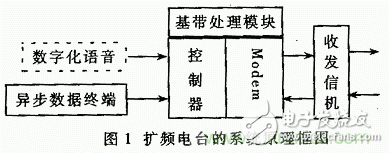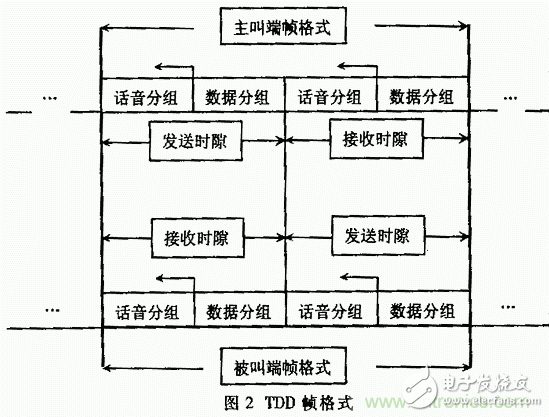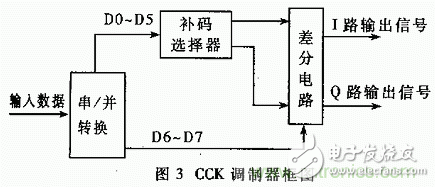WLAN (Wireless LAN) has more and more attention because of its flexible network configuration, rapid networking, user/terminal mobility, adaptability, and easy installation and maintenance. In this paper, the WLAN chip and DSP chip are used to design and fabricate the baseband processing module of the spread spectrum radio. This module utilizes the mature wireless transmission technology of WLAN and high-speed digital signal processing technology, and has the advantages of simple equipment and flexible configuration.
1 baseband processing module hardware system design
1.1 System structure of spread spectrum radio
The system block diagram of the spread spectrum radio is shown in Figure 1. It is mainly composed of a baseband processing module, a transceiver, an interface circuit and the like.

The baseband processing module of the spread spectrum radio mainly includes two parts: a controller and a modem. The baseband Modem uses Intersil's WLAN chip HFA3861B, which supports the physical layer protocol of IEEE802.11[1] IEEE802.11b[2]. The baseband controller uses TI's high-speed DSP-TMS320C5402[3], which has strong digital signal processing capabilities. The baseband processing module is mainly based on the hardware platform built by HFA3861B. The software of DSP completes its functions and integrates organically to maximize the effectiveness of communication.
1.2 baseband controller
The baseband controller mainly performs the following functions:
·Read and write of various business data (voice and asynchronous data)
(1) Exchange asynchronous data with the microcomputer through the RS232 serial port, and the serial port rate is 38.4 kbps.
(2) Exchanging digitized voice information with the vocoder.
Spread spectrum stations use Time Division Duplex (TDD) mode to divide the time axis into time frames, as shown in Figure 2.
Each frame is divided into two time slots: transmit and receive time slots. Each time slot is further divided into two parts for transmitting voice and data services. The boundaries of the voice portion can vary dynamically. When the user does not transmit voice information, the entire time slot is provided for use by the data service.

The user who initiates the service request first is the calling party, and the called user is the called party. The user can only send data in its transmit time slot and receive data in its receive time slot. When the calling end is in the sending time slot, the called end is in the receiving time slot; when the calling end is in the receiving time slot, the called end is in the transmitting time slot.
1.3 baseband Modem
The baseband Modem mainly performs the following functions:
Protocol conversion: Convert TDD data frames into IEEE 802.11 frame format.
·Modem
Baseband Modem supports the physical layer standard of IEEE802.11 and IEEE802.11b protocols, namely 11dB spread spectrum processing gain; modulation mode: DBPSK, QPSK, CCK; transmission speed; 1/2/5.5/11Mbps, where complement keying ( CCK) can transmit at a lower error rate and higher speed. The modulator block diagram is shown in Figure 3 [4, 5].
The input 8bits serial data is divided into 8 channels by serial/parallel conversion, wherein D0~D5 are used to select the CCK codeword. That is to say, one of the 64 orthogonal complements in the memory is extracted according to a certain rule, and the obtained complement (ie, CCK codeword) has a length of 8 chips. In this way, the 6-bit information is modulated onto the 8 chips's complement. The obtained CCK codeword is a complex code, including a real part and an imaginary part, and is correspondingly divided into two inputs of I and Q into the differential circuit. In the differential circuit, D6 to D7 select one of four phases (0°, 90°, 180°, 270°) and use this phase to flip the CCK codeword. Since both I and Q signals are flipped by AejQ, the two signals remain orthogonal and therefore less affected by channel distortion.
As a new type of modulation, CCK can transmit signals at a higher rate, better bandwidth utilization, stronger multipath interference capability, and lower bit error rate.
2 baseband module software design
The task of the baseband Modem is mainly done by the HFA3861B. The task of the baseband controller is mainly done by software, and several tasks occur at the same time, so they should be processed in parallel by interrupt mode during the working process of the software.
2.1 Protocol Implementation Framework
Because the software design and the hardware circuit are very tightly combined, in order to reduce the impact of the hardware circuit on the protocol processing part, a driver layer module is designed at the lowest layer of the software, mainly completing the initialization of the hardware circuit.
The processing of the data link layer core protocol is completed on the basis of the driver layer. This layer is the main part of the software. The main function is to load/unframe and upload/down data. In addition, the IEEE 802.11 protocol mainly supports asynchronous data services, and therefore uses a cyclic redundancy check (CRC). With the high-speed computing power of TMS320C5402, (2,1,5) convolutional coding [6] was developed. Because of its strong forward error correction (FEC) capability, it is more suitable for supporting real-time voice services, which provides convenience for the station's spread spectrum communication function.
2.2 System initialization
After the system is started, enter the initialization process. The initialization program of the system mainly completes the initialization of the HFA3861B and RS232 interfaces.
2.3 Data Transceiver
·Read and write to the RS232 serial port of the microcomputer

• Reading and writing to HFA3861B is in the transmission time slot. If the baseband controller has data to transmit and the baseband modem allows data to be sent, the interrupt notification controller is generated, and then the controller starts the transmission procedure and transmits the data to the modem. After receiving the data, the Modem first frames the frame according to the IEEE802.11 protocol frame format before it can be sent out.
The high-speed DSP-based spread spectrum radio baseband module can realize full-duplex communication with the microcomputer through the RS232 serial port, and the serial port rate is 38.4 kbps. The module supports IEEE802.11 and IEEE802.11b physical layer protocols, supports spread spectrum communication and CCK modulation, and has the advantages of high communication rate (highest channel transmission rate up to 11Mbps) and strong anti-interference ability. After many experiments, the module works stably and the communication is reliable. In addition, the module has further development potential as a general-purpose hardware platform that can be easily upgraded to a radio station with multiple communication functions (such as real-time voice service).
Oilfield Gas Generator,Gas Power Generator,Green Power Gas Generator,Small Gas Generator
Jiangsu Vantek Power Machinery Co., Ltd , https://www.vantekpower.com